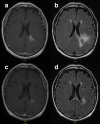New Directions in Anti-Angiogenic Therapy for Glioblastoma
- PMID: 28083806
- PMCID: PMC5398985
- DOI: 10.1007/s13311-016-0510-y
New Directions in Anti-Angiogenic Therapy for Glioblastoma
Abstract
Anti-angiogenic therapy has become an important component in the treatment of many solid tumors given the importance of adequate blood supply for tumor growth and metastasis. Despite promising preclinical data and early clinical trials, anti-angiogenic agents have failed to show a survival benefit in randomized controlled trials of patients with glioblastoma. In particular, agents targeting vascular endothelial growth factor (VEGF) appear to prolong progression free survival, possibly improve quality of life, and decrease steroid usage, yet the trials to date have demonstrated no extension of overall survival. In order to improve duration of response and convey a survival benefit, additional research is still needed to explore alternative pro-angiogenic pathways, mechanisms of resistance, combination strategies, and biomarkers to predict therapeutic response.
Keywords: Angiogenesis; Bevacizumab; Glioblastoma; Glioma; VEGF.
Figures




References
-
- Stupp R, Mason WP, van den Bent MJ, et al. Radiotherapy plus concomitant and adjuvant temozolomide for glioblastoma. N Engl J Med. 2005;352:987–996. - PubMed
-
- Friedman HS, Prados MD, Wen PY, et al (2009) Bevacizumab alone and in combination with irinotecan in recurrent glioblastoma. J Clin Oncol 27:4733–4740 - PubMed
-
- Taal W, Oosterkamp HM, Walenkamp AME, et al (2014) Single-agent bevacizumab or lomustine versus a combination of bevacizumab plus lomustine in patients with recurrent glioblastoma (BELOB trial): A randomised controlled phase 2 trial. Lancet Oncol 15:943–953 - PubMed
Publication types
MeSH terms
Substances
Grants and funding
LinkOut - more resources
Full Text Sources
Other Literature Sources
Medical

